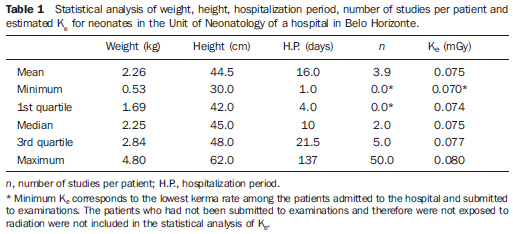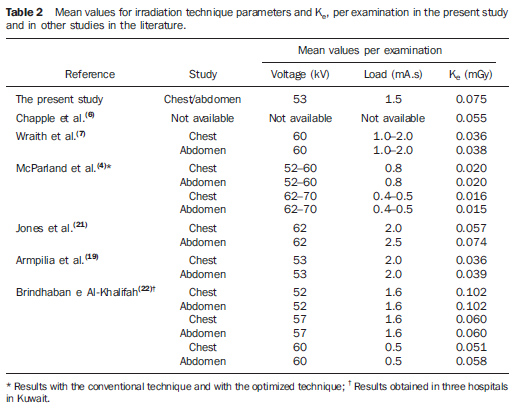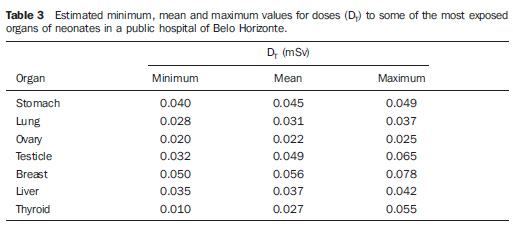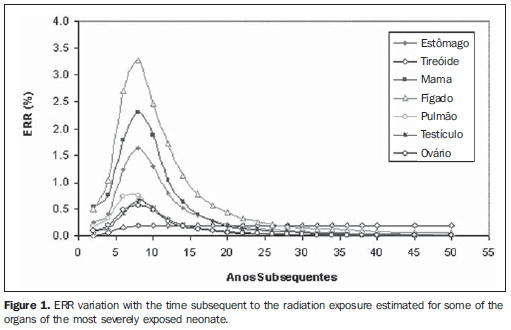Radiologia Brasileira - Publicação Científica Oficial do Colégio Brasileiro de Radiologia
AMB - Associação Médica Brasileira CNA - Comissão Nacional de Acreditação
 Vol. 41 nº 5 - Sep. / Oct. of 2008
Vol. 41 nº 5 - Sep. / Oct. of 2008
|
ORIGINAL ARTICLE
|
|
Risks of radiographic procedures for neonates admitted to a public hospital in Belo Horizonte, MG, Brazil |
|
|
Autho(rs): Marco Aurélio de Sousa Lacerda, Teógenes Augusto da Silva, Helen Jamil Khoury, José Nelson Mendes Vieira, João Paulo Kawaoka Matushita |
|
|
Keywords: Patient dosimetry, Radiological protection, Pediatric radiology, Cancer risk |
|
|
Abstract:
IPhD, Assistant Researcher at Centro de Desenvolvimento da Tecnologia Nuclear - Comissão Nacional de Energia Nuclear (CDTN-CNEN), Belo Horizonte, MG, Brazil
INTRODUCTION Diagnostic radiology is considered as the main artificial radiation source to which human beings are exposed, being responsible for about 14% of the total annual absorbed radiation dose as a result of overall radiation exposure to the general population(1). Considering that any radiation exposure can induce a risk for harmful effects, it is indispensable that a request for radiological examinations is preceded by a careful evaluation of risks versus benefits(2). Special attention should be paid to radiographic examinations in children, considering their higher susceptibility to the harmful effects of radiation as compared with the rest of the population(3). In units of neonatology, particularly in cases where the patients are typically found in adverse clinical circumstances, the request for a number of radiographic studies may represent a significant increase in the risk for these patients(4). Studies developed in units of neonatology have demonstrated a great variation in radiographic technique conditions (voltage, filtration, load, screen-film combination, etc.) and, consequently, in the absorbed-dose to newborn patients(5-8). In this sense, an optimization of radiographic procedures, particularly with the application of quality criteria recommended by the European Community(9,10), can significantly reduce dose to patients without impairing the quality of radiographic images. The estimation of the entrance surface air kerma rate (Ke) for inpatients of units of neonatology can be performed with the utilization of thermoluminescent dosimeters, dose-area product meters, or could be indirectly evaluated on the basis of radiographic technique parameters. This latter method, employing radiographic technique parameters in association with measurements of the x-ray equipment output is usually appropriate for this purpose(6). Based on Ke, magnitudes related to risks, such as dose to organs, can be obtained with appropriate conversion coefficients shown in tables available in the literature(11,12) or by means of some softwares(13-16). So, based on the dose to organ, the risk of an exposed individual for developing a determined type of cancer (in the irradiated organ) as compared with a non-exposed individual can be determined with the aid of appropriate models available in the literature(17). The present study encompasses two objectives: a) to evaluate radiographic procedures and Ke in preterm neonates submitted to chest and abdominal radiography in the unit of neonatology (not ICU) of a public hospital in Belo Horizonte, MG, Brazil; b) to estimate dose to organs and respective risks for developing cancer in these organs as a result of the radiation exposure.
MATERIALS AND METHODS Records of inpatients of the unit of neonatology in a public hospital of Belo Horizonte in the period between May and September 2004 were reviewed and the following individual data were recorded for the purposes of the present study: a) identification number; b) sex; c) weight; d) height; e) admission date; f) discharge date; g) chest and abdominal radiographic studies performed. Chest and abdomen account for 75% of radiographic procedures in neonates performed in this hospital. The equipment utilized for radiographic images acquisition was a portable, monophase Movix 120 system with 1.5 mm aluminum filtration and full-wave rectification exclusively utilized in the unit of neonatology. All the images were acquired with the neonates in their respective incubators. Estimation of Ke values was based on the x-ray tube output. For this purpose, measurements of air kerma were performed with a MDH 10X5-6 ionization chamber (Radcal Corp.; Monrovia, USA) with an electrometer MDH 9015 (Radcal Corp.; Monrovia, USA), both previously calibrated. The ionization chamber was positioned on the center of the radiation field at a distance of 100 cm from the focus, and at 20 cm from the floor. Based on the x-ray tube output and irradiation parameters utilized in the examinations, the authors could estimate the incident air kerma (Ki) and Ke, by means of the following equations:
where: Ri = x-ray tube output for the radiographic technique employed, in mGy/mAs; Q = tube current (I) by exposure time (t) employed in the examination, in milliampere/second (mA.s); Dref = distance where the output was measured (1 m); DFP = focus-skin distance, in meter, estimated by the difference between the focus-film distance (FFD) and the patient equivalent diameter (De) (equation 3)(18); BSF = nondimensional retroscattering factor. This is a function of the field size, equipment filtration and radiographic technique employed. A fixed value of 1.16 for BSF was adopted in the present study(19).
where: H = patient's height in meter; W = patient's weight in grams. Based on Ki, patient´s characteristics and radiographic techniques employed, the dose to the most exposed organs was evaluated by means of the software PCXMC(14), developed by Finnish Centre for Radiation and Nuclear Safety. So, the patient´s lifetime risk for developing cancer was estimated for some of the most exposed organs, by means of the software IREP (Interactive RadioEpidemiological Program)(17), developed by National Institute of Cancer in the United States of America. The IREP operation is based on risk models (excess relative risk - ERR; a measurement of change in the relative risk for cancer or death for a group of individuals exposed to a known radiation dose as compared with a non-exposed group), on a magnitude denominated assigned share (AS), defined by the equation 4, for a specific age where the cancer was diagnosed. In the present study, the AS was calculated by the IREP for the most severely irradiated individual at each year subsequent to the radiation exposure (totaling 50 years) and converted into ERR, a procedure similar to the one adopted by Thierry-Chef et al.(20).
RESULTS Considering that, in the hospital evaluated, simultaneous irradiation of both regions (chest and abdomen) in a same examination is frequent, the results were jointly reported as a single chest/abdominal acquisition. So, dose to organs were estimated assuming an irradiation field covering both regions. Table 1 presents the statistical analysis of weight, height, hospitalization period, number of chest/abdominal studies per patient, and Ke estimated for the newborn inpatients of the unit of neonatology. Mean parametric values (voltage, load, time, focus-film distance) usually adopted by the technicians for the chest/abdominal radiographic examinations of the neonates were, respectively: 53 kV, 1,5 mA.s, 50 ms, 95 cm.
Table 2 shows a comparison between radiographic technique parameters and mean values for Ke, per study found for the neonates in the present study and those reported in the literature.
Table 3 presents minimum, mean and maximum doses to some of the most exposed organs, estimated per study.
Figure 1 shows ERR variation with the time subsequent to the exposure estimated for some of the organs of the most severely exposed neonate (i.e. the patients submitted to 50 examinations).
DISCUSSION The statistical analysis of weight and height of the neonates, as well as hospitalization period presented on Table 1, corroborates the preterm condition of the inpatients in the unit of neonatology and the necessity of special care to be provided to these neonates. Such special care is translated into a significant number of radiographic studies per patient. On average, the neonates were submitted to 3.9 chest/abdominal radiographic examinations, over a mean 16-day hospitalization period. It is important to note that one of the patients was submitted to an exceptionally high number of examinations (50) over a 137-day hospitalization period. The analysis of radiographic technique parameters demonstrates that the x-ray tube voltage (kV) utilized for chest examination is below that recommended by the European Community (60-65 kV). On the other hand, the exposure time utilized is higher than recommended (4 ms), and the focus-film distance is shorter than recommended by the European Community (100-150 cm). Also, additional copper filters have not been utilized during the procedures as recommended by the European Community(10). The analysis of Table 2 demonstrates that the mean Ke per examination found in the present study is below the reference level suggested by the European Community(10) (0.080 mGy). However, this value is higher than the mean values reported by the majority of studies in the literature(4,6,7,18,20). The fact that the mean Ke per examination has been higher than the reference level recommended by the European Community, despite the non-optimization of the irradiation parameters. Can be partially explained by the low x-ray equipment output. Previous results of quality control tests have shown that the equipment time and voltage accuracy and reproducibility are in compliance with the technical performance standards established by the Brazilian authorities(23). However, the half-value layer at 80 kV (1.75 mm of Al) was significantly below of the minimum value established by the mentioned technical standard (2.3 mm of Al); that is to say, the x-ray tube output is low, even with the utilization of inadequate filtration. Considering that the hospital technicians already operate with minimum values for time and current, it may be concluded that besides the x-ray equipment inappropriateness for examining neonates, the optimization of the radiographic techniques in compliance with European Community recommendations is not feasible. This fact demonstrates that, probably, the quality of radiographic images is currently impaired. But this latter assertion only could be confirmed by further studies involving a joint evaluation of dose and image quality(24). Table 3 demonstrates that mean doses to the gonads (testicles and ovaries) and thyroid were relatively high. This fact demonstrates that an accurate collimation of the x-ray field, limiting the irradiated area to the chest and abdomen (provided it is clinically acceptable), and the utilization of lead shielding in the incubators or collimator lead shields would certainly reduce the dose to at least one of these organs. The analysis of Figure 1 demonstrates that liver (maximum ERR = 3.4%), breast (maximum ERR = 2.3%) and stomach (maximum ERR = 1.7%) are most susceptible to the development of cancer. In the case of the liver, this ERR value represents an increase in the risk for cancer from 89/10.000 (baseline)(25) to 92/10.000. The maximum ERR is typically observed eight years after the exposure. In the case of the thyroid, this maximum ERR persists over the patient´s lifetime. In the other organs, the ERR tends to decrease to values near zero over the patient´s lifetime. Considering that these results refer to the most severely exposed patient, who was submitted to a number of examinations 12 times higher than the average for the unit (~ four examinations/patient), it may be concluded that the neonates' risk for developing several types of cancer in the future as a result of these examinations is relatively low as compared with the benefits from the appropriately justified radiographic examinations. That is to say that the extremely adverse conditions of some neonates and the relevance of the radiodiagnosis as an essential clinical tool in the improvement of the management of the patient could justify this higher risk.
CONCLUSIONS Doses and risks for preterm neonates admitted to a public hospital in Belo Horizonte were investigated. The authors observed that the mean Ke/examination found in the present study is below the reference level suggested by the European Community(10) and above the mean values found in a considerable number of studies in the literature. However, the adoption of non-optimized radiographic technique parameters imposed by the utilization of a x-ray equipment with low output and inappropriate for examination of neonates, is probably impairing the radiographic images quality. But this hypothesis could only be confirmed by further studies involving a joint evaluation of dose and image quality. It was suggested that an appropriate collimation of the x-ray field and/or the utilization of lead shielding (as clinically acceptable) for reducing the doses to the thyroid and/or gonads. Liver, breast and stomach were most susceptible to the development of cancer. The optimization of radiographic procedures is essential for reducing the risk for neonates that, in spite of being considered to be low as compared with the benefits, should be reduced to values as low as reasonably achievable.
REFERENCES 1. United Nations Scientific Committee on the Effects of Atomic Radiation. Sources and effect of ionizing radiation. UNSCEAR Reports to the General Assembly of the United Nations, with annexes. New York: United Nations; 2000. [ ] 2. International Commission on Radiological Protection. 1990 Recommendations of the ICRP. ICRP Publication no. 60. Oxford: Pergamon Press; 1991. [ ] 3. Ron E. Cancer risks from medical radiation. Health Phys. 2003;85:47-59. [ ] 4. McParland BJ, Gorka W, Lee R, et al. Radiology in the neonatal intensive care unit: dose reduction and image quality. Br J Radiol. 1996;69:929-37. [ ] 5. Fletcher EWL, Baum JD, Draper G. The risk of diagnostic radiation of the newborn. Br J Radiol. 1986;59:165-70. [ ] 6. Chapple CL, Faulkner K, Hunter EW. Energy imparted to neonates during x-ray examinations in a special care infant unit. Br J Radiol. 1994;67:366-70. [ ] 7. Wraith CM, Martin CJ, Stockdale EJN, et al. An investigation into techniques for reducing doses from neonatal radiographic examinations. Br J Radiol. 1995;68:1074-82. [ ] 8. Wilson-Costello D, Rao PS, Morrison S, et al. Radiation exposure from diagnostic radiographs in extremely low birth weight infants. Pediatrics. 1996;97:369-74. [ ] 9. European Commission. Quality criteria for diagnostic radiographic images in paediatrics. CEC XII/307/91. Brussels: CEC; 1992. [ ] 10. European Commission. European guidelines on quality criteria for diagnostic radiographic images in paediatrics. EUR 16261 EN. Luxembourg: European Commission; 1996. [ ] 11. Hart D, Jones DG, Wall BF. Normalised organ doses for paediatric x-ray examinations calculated using Monte-Carlo techniques. NRPB-SR279. Chilton: National Radiological Protection Board; 1996. [ ] 12. Rosenstein M, Beck TJ, Warner GG. Handbook of selected organ doses for projections common in pediatric radiology. Rockville: U.S. Department of Health and Human Services; 1979. [ ] 13. Le Heron JC. CHILDOSE: a user's guide. Software and manual. Christchurch: National Radiation Laboratory; 1996. [ ] 14. Tapiovaara M, Lakkisto M, Servomaa A. PCXMC: a PC-based Monte Carlo program for calculating patient doses in medical x-ray examinations, report STUK-A139. Helsinki: Finnish Centre for Radiation and Nuclear Safety; 1997. [ ] 15. Kyriou JC, Newey V, Fitzgerald MC. Patient doses in diagnostic radiology at the touch of a button. London: The Radiological Protection Center, St. Georges Hospital; 2000. [ ] 16. Lacerda MAS, Khoury HJ, Silva TA, et al. Radioproteção, dose e risco em exames radiográficos nos seios da face de crianças, em hospitais de Belo Horizonte, MG. Radiol Bras. 2007;40:409-13. [ ] 17. Land CE, Gilbert E, Smith JM, et al. Report of the NCI-CDC Working Group to revise the 1985 NIH radioepidemiological tables. DHHS Publ No. 03-5387. Bethesda: National Institute of Health; 2003. Available in: http://dceg.cancer.gov/docs/report03.pdf. Interactive RadioEpidemiological Program (IREP) v.5.3. Online software available in: http://www.irep.nci.nih.gov/ [ ] 18. Lindskoug BA. Reference man in diagnostic radiology dosimetry. Radiat Prot Dosimetry. 1992;43:111-4. [ ] 19. Armpilia CI, Fife IAJ, Croasdale PL. Radiation dose quantities and risk in neonates in a special care infant unit. Br J Radiol. 2002;75:590-5. [ ] 20. Thierry-Chef I, Simon SL, Miller, DL. Radiation dose and cancer risk among pediatric patients undergoing interventional neuroradiology procedures. Pediatr Radiol. 2006;36 Suppl 14:159-62. [ ] 21. Jones NF, Palarm TW, Negus IS. Neonatal chest and abdominal radiation dosimetry: a comparison of two radiographic techniques. Br J Radiol. 2001;74:920-5. [ ] 22. Brindhaban A, Al-Khalifah K. Radiation dose to premature infants in neonatal intensive care units in Kuwait. Radiat Prot Dosimetry. 2004;111:275-81. [ ] 23. Ministério da Saúde, Agência Nacional de Vigilância Sanitária. Radiodiagnóstico médico: desempenho de equipamentos e segurança. Brasília: Ministério da Saúde; 2005. [ ] 24. Osibote AO, Azevedo ACP, Carvalho ACP, et al. Exposição de pacientes e qualidade da imagem em radiografias de tórax: uma avaliação crítica. Radiol Bras. 2007;40:119-22. [ ] 25. Ries LA, Eisner MP, Kosary CL, et al. SEER Cancer statistics review, 1975-2002. Bethesda: National Cancer Institute; 2005. [ ] Received March 10, 2008. Accepted after revision July 17, 2008. * Study developed at Centro de Desenvolvimento da Tecnologia Nuclear - Comissão Nacional de Energia Nuclear (CDTNCNEN), Belo Horizonte, MG, Brazil. |
|
Av. Paulista, 37 - 7° andar - Conj. 71 - CEP 01311-902 - São Paulo - SP - Brazil - Phone: (11) 3372-4544 - Fax: (11) 3372-4554







